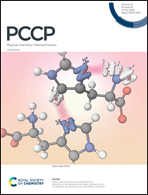Exoergic pathways triggered by O/H radicals in different metallic carbohydrazide perchlorates (M2+ = Mn2+, Fe2+, Co2+, Ni2+, Zn2+ and Cd2+)†
Abstract
Metallic carbohydrazide perchlorates (M[(N2H3)2C = O](ClO4)2, M2+ = Mn2+, Fe2+, Co2+, Ni2+, Zn2+ and Cd2+, simplified as MCPs) are a series of energetic primary explosives, among which ZnCP and CdCP are already applied in civilian/military fields. The six MCPs possess similar structures but demonstrate different energetic performances in their decomposition, which are obviously determined by their different central metals. Here, we apply DFT and Car–Parrinello molecular dynamics (CPMD) to understand the electronic structures and decomposition pathways of the MCPs. Based on the results, the crystal MCPs with larger electronic band gaps show lower impact sensitivity. However, the friction sensitivity of MCPs is dominated by the strength of their intermolecular O⋯H interactions. In the CPMD simulations, we obtained a different conclusion from the traditional viewpoint, where the decomposition is spontaneous from the cleavage of M–N bonds. Indeed, there are two stages in the decomposition of the MCPs, based on our calculations: (I) nonspontaneous 3-step departure of the CHZ groups and (II) spontaneous exoergic decomposition pathways of the CHZ groups triggered by the transfer of O/H radicals. Our study provides a systematic study of the MCP family, which also affords a new route for understanding the relationship between the energetic properties and electronic structures of energetic metal complexes.



 Please wait while we load your content...
Please wait while we load your content...